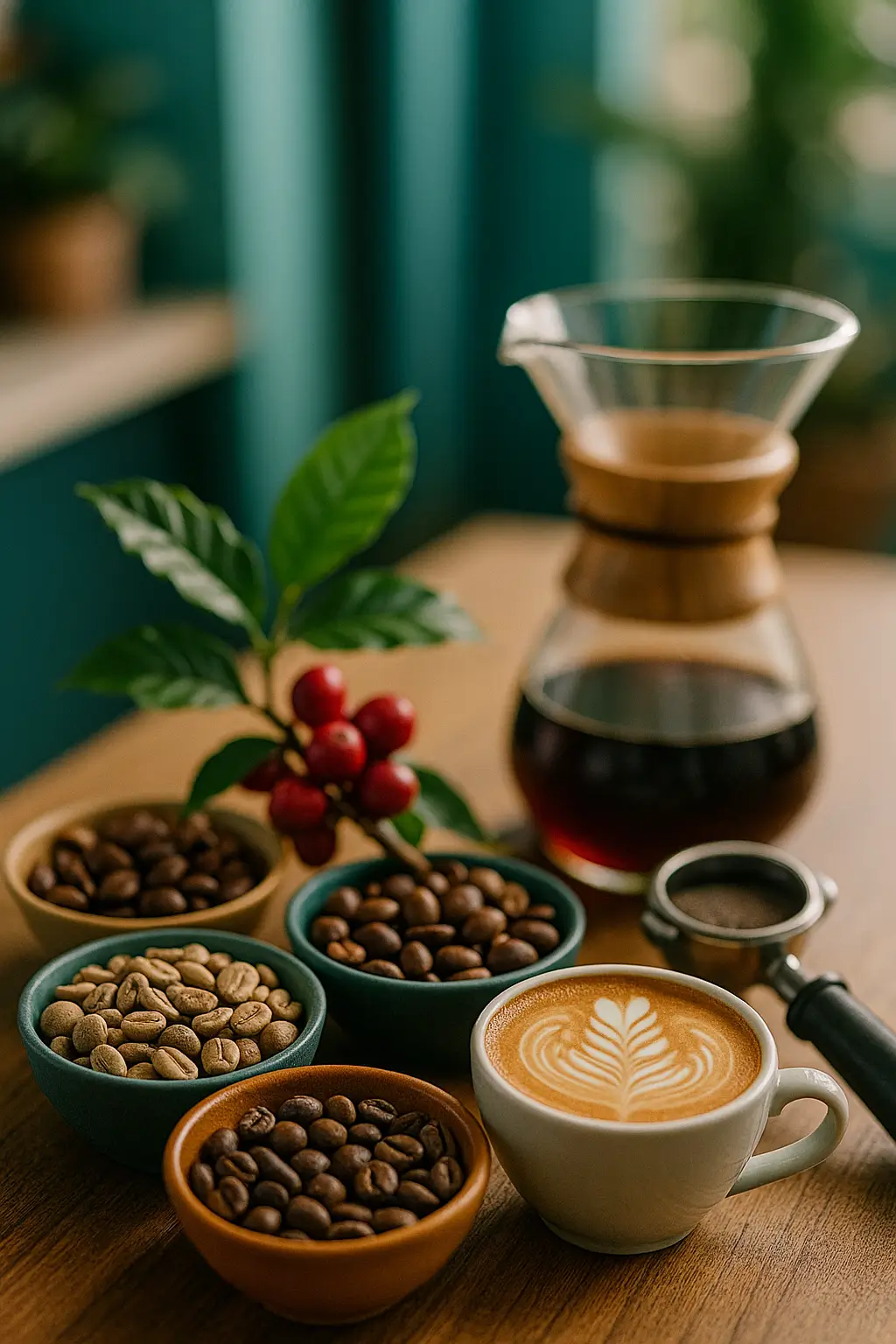Coffee is more than just a morning drink. It is a world of flavors, aromas, and experiences. The beans you choose shape your cup. Knowing these differences helps you enjoy every sip. This guide explores the main types of coffee beans: Arabica, Robusta, and the rarer Liberica and Excelsa. You will learn what makes each bean unique, from its plant origins to its journey from farm to cup.
- Major coffee bean species and their differences: Arabica versus Robusta and beyond
- How coffee bean varieties influence flavor and profile
- How growing regions and environmental factors influence coffee beans
- How coffee processing methods shape the cup
- Impact of roast levels on coffee flavor
- Beyond the basics: Lesser-known and specialty varieties
- Understanding different types of coffee beans: Key takeaways
Major coffee bean species and their differences: Arabica versus Robusta and beyond
Coffee beans come from the Coffea genus. Coffea arabica and Coffea canephora (Robusta) are the most common worldwide. Their botanical class defines their core traits. Understanding these main differences helps you appreciate coffee’s diverse world.
Arabica: The connoisseur’s choice
Arabica beans are a connoisseur’s choice. They make up about 60% of global coffee output because of their quality. These beans have a delicate, complex flavor. People call them sweeter, zesty, and fruity. You might find notes of floral, wine, chocolate, or caramel in a good cup. Arabica beans also have less caffeine than other types. This gives them a smooth, refined taste. Arabica plants need specific conditions. They grow best in high-altitude (800–2,200 meters), cool subtropical areas with moderate rain. This makes them harder to grow. This careful farming delivers the exceptional quality found in specialty coffee. Many people enjoy Arabica as filter coffee or a refined espresso.
Robusta: The bold powerhouse
Robusta beans are the coffee world’s bold powerhouse. They taste stronger, more bitter, and often harsh. This bean often has earthy, woody, and nutty notes. Robusta has much more caffeine than Arabica. It gives you a more intense kick and a fuller body. It resists diseases and pests well, so it grows easily at lower altitudes and in warmer climates. People commonly use Robusta in instant coffee and espresso blends. Its thick crema and greater solubility are valuable, especially in mass-market coffee products.
Liberica and Excelsa: The rare gems
Liberica and Excelsa beans are less common but unique. They offer distinct flavor profiles. Liberica has a unique fruity, floral, and spicy taste. People often describe notes of dark cherry, smoky wood, and chocolate. It has an intense bitterness with a lingering aftertaste. It holds a very small share of global production, usually less than 2%. Most Liberica is consumed locally in niche markets. Excelsa is sometimes a Liberica variety. It gives complex, tart fruity flavors, like blueberries and tart cherries. These blend with hints of honey and nuts. Both Liberica and Excelsa offer adventurous drinkers a chance to explore truly unique tastes from the niche coffee market.
How coffee bean varieties influence flavor and profile
Even within broad species like Arabica, specific varieties offer distinct subtleties. These influence their overall flavor. Such variations add to the wide range of tastes you experience. The plant variety’s inherent traits play a crucial role in its sensory output.
Distinct flavors of Arabica varieties
Different Arabica varieties show a spectrum of subtle flavor nuances. These add to a rich, complex cup. Consider these popular types:
- Typica Variety: Offers a balanced flavor with moderate acidity, a foundational taste.
- Bourbon Variety: Prized for sweet, floral notes, giving a delicate, aromatic experience.
- Caturra Variety: Tends to show more pronounced fruity, spicy notes, adding a vibrant twist.
- Geisha Variety: Celebrated globally for exceptionally delicate floral, tea-like flavors, a peak of quality in specialty coffee.
These distinct varietal traits contribute to the broad range of smooth, sweet, complex profiles you find in Arabica coffee.
Robusta characteristics and use
Robusta coffee beans have a dominant flavor profile. It is strong, bitter, earthy, and nutty, with lower acidity. These traits give it a robust, full-bodied nature. Robusta’s specific flavor and physical characteristics make it good for certain uses. It provides significant intensity and a thick, desirable crema, essential for high-quality espresso blends. Its bold flavor also stands up well to milk and sugar. This makes it a popular choice for many traditional coffee drinks.
Unique profiles of Liberica and Excelsa
Liberica offers a distinct flavor. It has robust, smoky, and dark fruit notes, often with floral undertones and intense bitterness. This combination gives a unique, memorable taste. Excelsa presents tart fruity flavors like blueberries or tart cherries. Hints of honey and nuts complement them. Both species are less common. But they offer exotic, compelling flavors for the adventurous palate.
How growing regions and environmental factors influence coffee beans
“Terroir” greatly impacts coffee beans. Environmental conditions deeply shape a bean’s character. This includes everything from soil to climate. These dictate the final flavor. A coffee bean’s journey from seed to cup is deeply influenced by its immediate surroundings.
The “Bean Belt” and global distribution
The “Bean Belt” is a tropical zone. It sits between the Tropics of Cancer and Capricorn. Most of the world’s coffee beans grow here. This specific geographical band offers ideal climate conditions. Arabica beans grow best at higher elevations within this belt. You find them in Latin America (Brazil, Colombia, Guatemala, Honduras) and East Africa (Ethiopia, Kenya). They also grow in parts of Asia like Yemen and India. Robusta beans grow more easily at lower elevations. Countries like Vietnam (the top Robusta producer), Indonesia, India, Brazil (in specific states), and Central African countries like Uganda and Côte d’Ivoire grow them. Each region in the Bean Belt has distinct environmental factors. These produce unique coffee flavors.
Key environmental influencers: Altitude, climate, soil, and biochemical compounds
Key environmental factors heavily influence coffee bean development. Altitude is crucial. Higher elevations lead to denser beans, giving more acidity and complex flavors. For example, Ethiopian coffee often has distinct spice and mocha notes. Kenyan coffee shows bright acidity. Climate, specifically temperature and rainfall, affects sugar development in the beans. This enhances their sweetness and body. Cooler temperatures, like those for Indian Arabicas, often produce milder acidity. Warmer, humid conditions contribute to a fuller body. Soil Composition also impacts plant health and bean flavor. Nutrient-rich soils, like volcanic or loamy soils, influence taste. For instance, Bourbon from Rwanda’s volcanic soils tastes different from the same variety grown in Colombia’s loamy soils. These environmental factors also change the levels of key Biochemical Compounds. Caffeine, chlorogenic acids, trigonelline, and sucrose all contribute to the final taste and characteristics of the bean.
Post-harvest environmental exposure
Unique post-harvest methods use environmental factors to shape coffee flavor. The Monsooning Process is unique to India. It exposes coffee beans to humid monsoon air for a long time. This gives beans lower acidity and a distinct pale golden color. It is known as monsooned coffee. Similarly, the Aging Process, especially in Indonesia, stores beans in warehouses under specific conditions. This aging creates a deep body, mild acidity, and adds unique earthy, tobacco, spice, and leather notes to the coffee. These methods show how the environment, even after harvest, keeps influencing the bean’s final profile.
How coffee processing methods shape the cup
Coffee processing methods greatly impact the final taste, body, acidity, and sweetness. These methods decide how much fruit pulp and mucilage stay on the bean during drying. This fundamentally alters its flavor development. Each approach gives you a distinct sensory experience.
Washed (wet) process
The Washed Process, or wet process, is common. All fruit pulp and mucilage are removed from the bean before drying. This involves:
- Depulping the cherries.
- Fermenting them in water tanks to break down remaining mucilage.
- Thoroughly washing the beans.
This precise method results in a clean, bright cup. It has crisp acidity and clear, distinct floral flavors. Washed coffees usually have a lighter body. They emphasize the bean’s intrinsic qualities rather than the fruit’s influence.
Natural (dry) process
The Natural Process, or dry process, dries whole coffee cherries with the fruit intact. This traditional method allows long fermentation. Sugars from the fruit soak into the bean during drying. The result is coffee with bold, sweet, intensely fruity, sometimes wine-like flavors. Natural processed beans also have a heavier body and lower acidity. This makes for a rich, complex taste. The fruit’s influence is very prominent. It adds layers of sweetness and complexity.
Honey process: The balanced approach
The Honey Process, also called pulped natural, is a hybrid method. It combines elements of both washed and natural processing. The outer skin of the coffee cherry is removed. But some or all of the sticky mucilage layer (the “honey”) stays on the beans during drying. This careful approach creates a balanced cup. It offers a delightful mix of sweetness and body. Flavor notes often include honey, caramel, stone fruit, and mild tropical fruits. It has a velvety mouthfeel and medium acidity. Variations, like yellow or black honey, depend on the amount of mucilage left and the drying conditions. This leads to subtle flavor differences.
Impact of roast levels on coffee flavor
Roast levels are a critical final step. They shape coffee’s flavor, acidity, and body. This is true for any bean type or origin. Roasting turns raw green beans into the aromatic, flavorful product we enjoy. Different roast levels highlight distinct characteristics of the underlying beans.
Light roasts preserve delicacy
Light roasts aim to preserve the natural acidity and delicate flavors of the beans. Roasting stops shortly after the “first crack.” This prevents too much sugar caramelization. The coffee often has brighter, more delicate flavors. Think citrusy, floral, or tea-like notes. Light roasts also have a lighter body. This lets the unique origin characteristics and nuanced coffee flavors truly shine.
Medium roasts offer balance
Medium roasts strike a good balance between acidity and body. Many coffee drinkers prefer them. Beans roast longer than light roasts. But not enough to develop smoky or bitter traits. This level highlights sweeter notes. People often describe them as nutty, caramel, or chocolate. They have a noticeably smoother mouthfeel. Medium roasts offer a fuller body than light roasts. They still keep much of the bean’s original flavor. They give a versatile, widely appreciated cup.
Dark roasts achieve bold, intense flavors
Dark roasts mean longer roasting times. This results in lower acidity and a much fuller body. During dark roasting, beans get a deeper color and an oily sheen. Their internal oils move to the surface. These roasts develop bolder, more intense flavors. Think smoky, chocolaty, or burnt sugar notes. These often overshadow the bean’s original origin. Dark roasts are popular for those who want a strong, robust cup with minimal acidity.
Beyond the basics: Lesser-known and specialty varieties
Beyond the main species and known varieties, a fascinating world of specialty and rare coffee beans exists. These unique varieties offer distinct sensory experiences for the discerning coffee enthusiast. Their scarcity and exceptional flavor often bring higher prices and recognition in niche markets.
Panamanian Geisha: The pinnacle of quality
Panamanian Geisha (Gesha) stands out. It is one of the rarest, highest-quality beans globally. This exceptional Arabica variety is prized for its exquisite floral, tea-like notes. It offers unmatched complexity and delicate aroma. Geisha beans came from Ethiopia but are famously grown in Panama, especially the Boquete region. They fetch premium prices. This is due to their challenging cultivation and highly sought-after, unique flavors. Its distinct characteristics make it a true treasure for coffee connoisseurs worldwide.
Kopi Luwak and its unique fermentation process
Indonesian Wild Kopi Luwak is a unique, often controversial, specialty coffee. It is known for its distinctive natural fermentation. Asian palm civets eat ripe coffee cherries. The beans then go through internal digestion before excretion. Enzymes in the civet’s gut break down proteins. This changes the bean’s chemistry. The result is coffee with smooth, complex earthy, caramel, and chocolate flavors. People highly prize its unique taste. But ethical concerns about civet sourcing and treatment remain. This leads to debates about its production.
Emerging and rare species
The world of coffee beans keeps growing. Emerging and ultra-rare species offer distinct experiences. Sierra Leone Highland Coffee (Coffea stenophylla) gets attention. It resists disease naturally and has a unique taste. It offers potential for future growth in tough environments. Similarly, Wush Wush, a rare Ethiopian Arabica heirloom, gives a complex mix of berry, floral, and spice notes. Other notable varieties like Eugenioides, Sidra, Pink Bourbon, and Laurina are making waves in specialty coffee. These rare gems have distinct genes. They offer very unusual coffee flavors. They appeal to enthusiasts seeking the peak of coffee diversity and rarity.
Understanding different types of coffee beans: Key takeaways
Finding the “perfect” cup of coffee involves many factors. It starts with the main types of coffee beans. From Arabica’s nuanced sweetness to Robusta’s bold intensity, and Liberica and Excelsa’s rare uniqueness, each species provides a distinct base for your brew. Beyond the species, specific varieties, the growing conditions (terroir), careful processing, and the final roast all shape the coffee’s flavor. This diversity creates endless possibilities for coffee exploration.
| Species | Flavor Profile | Caffeine Content | Growing Conditions | Common Uses |
|---|---|---|---|---|
| Arabica | Sweeter, zesty, fruity, floral, chocolate, caramel | Lower | High altitude (800–2,200m), cool subtropical, moderate rainfall | Specialty/Gourmet Coffee, Filter Coffee, Espresso |
| Robusta | Stronger, bitter, harsh, earthy, woody, nutty | Higher | Lower altitude, warmer climates, resilient | Instant Coffee, Espresso Blends, Mass-Market Coffee |
| Liberica | Fruity, floral, spicy, dark cherry, smoky wood, chocolate, intense bitterness | Low to moderate | Lowlands, hot, humid (Southeast Asia) | Niche local markets, unique experience |
| Excelsa | Tart fruity (blueberry, cherry), honey, nuts, complex | Moderate | Lowlands (Southeast Asia, considered a Liberica variety) | Niche market, adventurous palates |
Try different types of coffee beans. Explore various origins. Experiment with different roast levels. Visit a local specialty coffee shop to learn more about this incredible drink. Your next favorite cup is waiting.









